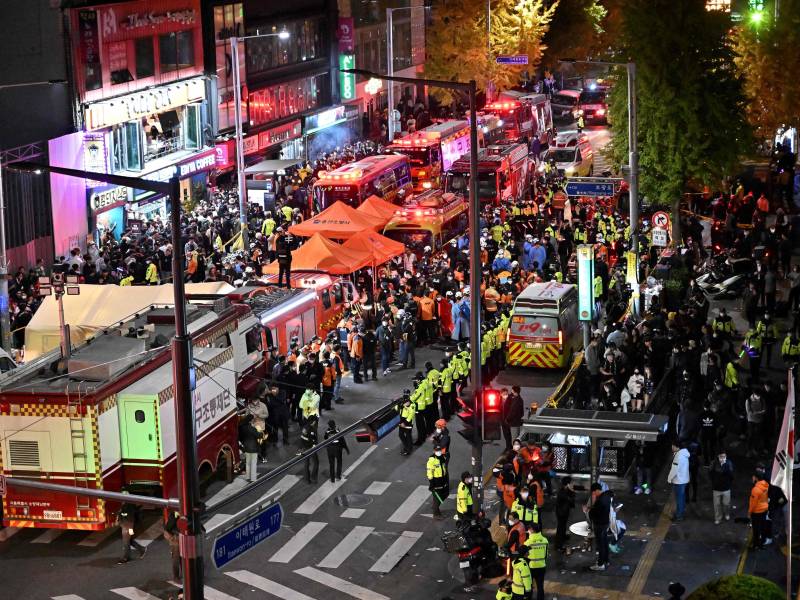“I actually like it,” he says. “I used to be afraid of crowds, before I was a scientist in this domain. But I think that was mostly because I didn’t know how the crowd works and what the behavioral mechanisms are. Now that I know how it functions, I feel kind of comfortable. So yeah, I’m not afraid anymore.”
Moussaïd, who wrote a book called Fouloscopie: Ce que la foule dit de nous, or Crowd study: What crowds say about us, compiled his tips for a widely cited article in The Conversation. In an interview with NPR, he expands on his advice.
This interview has been edited and condensed.
Interview highlights
Keep your eyes open for danger signs
Once you’re in a crowd and you start feeling the pressure, I’m afraid it’s almost already too late to act.
The best thing you can do is to try not to put yourself in this critical situation. The thing is, most people don’t realize that it’s dangerous. We don’t have this culture of being aware of the dangers of the crowd. And yes, indeed, it’s dangerous.
The most important advice is to be aware there could be a danger if the crowd is too dense around you.
Leave as soon as you sense the crowd getting too dense
If you start feeling uncomfortable, but you still have time and some freedom of movement — then just go away. It’s something that people don’t have in mind. They’re like, “Oh, I don’t feel good, but the concert is nice, so I’m going to just keep pushing and go toward the concert.”
No, don’t do that. If you feel bad, it means that really it’s dangerous. Just move away and keep yourself safe.
Stay standing, and don’t put a backpack on the ground
Staying on your feet is important because if you fall, it’s going to be really difficult to stand up again, precisely because there are too many people.
It also helps others because if you fall, you’re going to be an obstacle for your neighbors who are most likely going to fall in turn — possibly on your body — and this will create a chain reaction, a snowball effect. You don’t want to be under this big pack of people. That’s absolutely dangerous.
Obstacles are terrible. It could be a body in this worst-case scenario, but even just a backpack left on the ground would be an obstacle that increases the risk that somebody would fall on it.
Lack of oxygen is the killer in crowds, so preserve space around your chest
People often ask me, “Why do we die in a crowd? What’s the cause of death?” Well, the cause is not enough oxygen.
You’re so densely packed that your lungs don’t have enough space to do their job, and to keep you breathing. That’s one thing that is superuseful that people should be aware of: The problem is going to be breathing.
If you can maintain sufficient space for you to breathe, you’re going to be OK. Put your arms out just in front of your chest and hold them there. In this position, you would have some space, just a little bit, to push for half a centimeter or just 1 centimeter — enough for you to keep breathing.
It’s not going to be comfortable. You’re going to be feeling really bad, but at least you’ll survive.
Don’t push. Move with the crowd
In a crowd, everything is about chain reactions. When you push your neighbors, they’re going to push their own neighbors and it eventually hits an obstacle. Then the pushing is amplified — and it’s going to come back to you.
If you feel a push, don’t push back. Don’t amplify this wave. Just go with the flow. It’s not going to be comfortable, you’re not going to like it, but it’s the best way to behave in this situation. Don’t add pressure in the system.
In the worst moments, you have multiple pushing waves at once. This is what we call crowd turbulence. You don’t want to be where two waves cross, because the pressures come from opposite directions, and that’s really dangerous.
When we observe crowd turbulence, we see death, a tragedy.
Avoid walls and solid objects
When we look at where the injuries and fatalities happen in a tragedy, most of the time they happen along solid obstacles.
That makes sense, because if you go with the flow of pushing waves, you’re fine. But if you’re next to a wall, you cannot just go along, because the wall is preventing you. So the wave is going to crush you against the wall. That’s where you don’t want to be — so avoid obstacles.
Learn to detect crowd density
Density is really the critical variable, that’s the first thing we measure. It’s expressed as the number of people per square meter, and there are some thresholds:
Below five people per square meter [about 10.7 square feet], it’s fine. Maybe not comfortable, but it’s fine.
Above six persons per square meter, it starts becoming dangerous.
Eight people per square meter: Most of the time there are injuries or worse.
It’s superuseful to have a sense of that density, but it’s not intuitive. Here’s a tip: If you feel that people are touching you on both shoulders or on several places on your body at the same time, the density is probably around six or above. If you still have time and can move, get away. That’s an alarm signal.
If a crowd gets unsafe, look out for others
Helping behaviors and altruistic behaviors are kind of contagious in crowds. The same applies to individualistic or selfish behaviors.

9(MDAxOTAwOTE4MDEyMTkxMDAzNjczZDljZA004))
